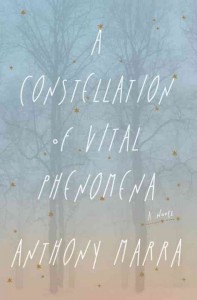Book Review: Vital, Phenomenal — Novelist Anthony Marra’s debut
A Constellation of Vital Phenomena is spectacular.
A Constellation of Vital Phenomena by Anthony Marra. Hogarth Press, 384 pages, $26.
By Debra Cash
In the spring of 2009, a young writer named Anthony Marra won the Narrative Magazine Prize with his first published short story, titled, simply “Chechnya.” Harrowing, fully realized, it knocked my socks off. I sent it to a circle of friends with the statement that this was the best fiction by a new writer I had read in at least a decade. Then I sent the young writer a fan letter and offered to buy him a cup of coffee if he ever got to Boston.
It turns out I was hardly alone. In the period between that award and this week’s publication of A Constellation of Vital Phenomena, the debut novel that grew out of that germ of a tale, Marra, a grad of the Iowa Writers Workshop, picked up a Stegner Fellowship, The Whiting Award, and a fistful of other accolades. Rights to the novel were sold in 14 countries.
A Constellation of Vital Phenomena is spectacular. In a meditation on brutality, resistance, mercy, and most of all the ways historic forces distort and refine individual and collective motivation, the story takes place in a too-recent-for-complacency time, interleaving five days during the winter of 2004 with the period of the Chechen wars beginning a decade earlier.
Given that this past month grown-up people had to be reminded of the difference between Chechnya and the Czech Republic, even knowledgeable readers may be forgiven for retaining only the sketchiest awareness of these wars, reduced as they have been to a siege and massacre at a school or a faintly tracked signal from the debris of the Soviet breakup. (Ignore anyone who feels this novel predicts or offers a key to the motivations behind the behavior of the Tsarnaev brothers, although that coincidence of timing may lend the book a grotesque marketing niche.)
Marra, in a Publishers’ Weekly q/a, noted that Russian press censorship and sealed borders kept information about the Chechen wars off the front pages. When he looked, he couldn’t find an English-language novel about them, although the murdered Russian journalist Anna Politkovskaya had written about the topic extensively. (Marra’s novel has an epigraph from Tolstoy’s Hadji Murad, which is set during the Russo-Chechen war of the nineteenth century, and that book makes a cameo appearance in A Constellation of Vital Phenomena.)
But Chechnya was in his mind. He had studied at Charles University in Prague and at St. Petersburg State University in Russia in 2007, and after being one of the first foreign tourists to visit Chechnya, he apparently was interviewed on Chechen television (!) for his impressions. What Marra is not is a tourist in other people’s suffering.

Anthony Marra — his compassion depiction of his characters gives this novel its authenticity and power. Photo: Smeeta Mahanti
Marra’s novel begins with the knockout sentence “On the morning after the Feds burned down her house and took her father, Havaa woke from dreams of sea anemones.” Havaa is eight, and a neighbor, Akhmed, the mediocre village doctor who would rather be an artist, realizing that the girl is being hunted by the same Russian soldiers who abducted her father, spirits her away to the denuded, local hospital for refuge. Sonja Rabina, the ethnic Russian introduced in Marra’s short story, is a weary, tough-minded surgeon driven by a search for her missing sister Natasha and resourceful enough to suture a man’s chest together with a line of dental floss. The other characters include Ramzan, Akhmed’s friend until he turned local informer, and Ramzan’s father Khassan, an elderly veteran who has spent four obsessive decades writing a 3,300 page historical survey of the Chechen lands.
Marra wraps unflinching observations of heart-rending and often grisly scenes in luminous prose with details that detonate in the mind: a land mine victim brought into the hospital writhes “like a lone noodle in a pot of boiling water.” Scenes are laced with gallows humor, with body bags requisitioned by government soldiers for improvised saunas and unexploded ordinance covered by the villagers under indestructible, Russian-made toilet bowls. The outside world intrudes into the village’s quasi-apocalyptic landscape when a sweatshirt zipped under a coat in Chechnya is traced back to a Red Cross clothing drive in Manchester, England. Every person in the novel is, like Sonja, physically or mentally confined to a trauma ward. The novel moves backward and forward in time, structured like a dossier that, leafed through, exposes unexpected inferences without warning.
But it is Marra’s compassionate depiction of his characters, both leading and minor, that gives A Constellation of Vital Phenomena its authenticity and power. These men, women, and children, their assailable bodies and inner lives rubbed raw, remain distinctly themselves despite and perhaps because of their circumstances.
Memory is articulated as nothing less than a moral imperative. Akhmed commemorates 41 villagers disappeared by the government on a single day by drawing their portraits on plywood boards and posting them throughout the village where they persist in living memory. Sonja recognizes that she shares with the voluble Akhmed a tendency to try to “resurrect by recitation” what has been lost.
Marra goes a step further in A Constellation of Vital Phenomena. He resurrects a terrible period in other peoples’ lives to air their neglected sorrows and share them with us for the first time.
Anthony Marra reads May 14, 2013 at the Harvard Book Store, Cambridge. Free
c 2013 Debra Cash

